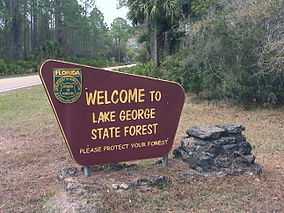Florida Department of Agriculture and Consumer Services
|
State Seal of Florida | |
|
FDACS Department Logo | |
| Department overview | |
|---|---|
| Formed | 1870 |
| Preceding agencies |
Florida Commissioner of Immigration Florida Commissioner of Lands and Immigration |
| Jurisdiction | Government of Florida |
| Headquarters |
The Capitol Tallahassee, Florida |
| Department executive | Adam Putnam, Commissioner of Agriculture |
| Child agencies |
Div. of Administration Div. of AES Div. of Animal Industry Div. of Aquaculture Div. of Consumer Services Div. of Dairy Industry Div. of Food Safety Div. of Forestry Div. of Fruit and Vegetables Div. of Licensing Div. of Marketing and Development Div. of Plant Industry Div. of Standards |
| Website | doacs.state.fl.us |
The Florida Department of Agriculture and Consumer Services (FDACS) is an executive department of the government of Florida.
The Commissioner of Agriculture (directly elected by voters statewide for a four-year term, and a member of the Florida Cabinet) is the head of the department. The current commissioner is Adam Putnam.[1]
History

The Florida Constitution of 1868 provided for the creation of the Office of Commissioner of Immigration, whose duties consisted of attracting settlers to engage in agriculture. The Florida Constitution was amended in 1871 to consolidate the offices of Surveyor General and Commissioner of Immigration as the new Commissioner of Lands and Immigration. In 1885, the Constitution was revised and the Commissioner of Lands and Immigration post was renamed Commissioner of Agriculture. The duties of the Commissioner of Agriculture were revised to include supervision of the state prisons. (A Division of Corrections was created in 1957 and state prisons were removed from the list of Commissioner of Agriculture responsibilities).

The Agricultural Services Reorganization Act (ASRA) was passed in 1959 and became effective January 15, 1961. This state law abolished some independent boards and bureaus, which were assigned to the Department of Agriculture's divisions. These included: Administration, Animal Industry, Dairy Industry, Fruit and Vegetable Inspection, Marketing, Plant Industry, Inspection and Standards. The State Chemist, a position that existed since 1891, was moved to the new Division of Chemistry.
The Legislature created the Office of Consumer Services in 1967. The Executive Reorganization Act of 1969 renamed the Office of Consumer Services the Division of Consumer Services and the Board of Forestry the Division of Forestry. The Department of Agriculture was renamed the Department of Agriculture and Consumer Services (FDACS).
The 1992 Legislature passed Chapter 92-291 of the Laws of Florida, which formally organized the Department of Agriculture and Consumer Services into the following divisions: Administration, Agricultural Environmental Services (AES), Animal Industry, Plant Industry, Marketing and Development, Dairy Industry, Food Safety, Fruit and Vegetables, Consumer Services, Forestry, Standards, Aquaculture, and Licensing.[3]
In addition to the above divisions, the FDACS includes separate offices for Agricultural Law Enforcement, Agricultural Water Policy, Agricultural Emergency Preparedness, the Inspector General, as well as for the Commissioner of Agriculture.[4]
Organization
The Department of Agriculture and Consumer Services is headed by the Commissioner, who is elected statewide to a four-year term. The Commissioner is assisted in managing the Department by a Chief of Staff, three Deputy Commissioners and one Assistant Deputy Commissioner. The Department is organizated into twelve programatic Divisions and one support Division, each headed by a Division Director. Each Division is subdivided into Bureaus, with each headed by a Bureau Chief. The Bureaus are further subdivided into Sections.
- Commissioner of Agriculture and Consumer Services
- Chief of Staff
- Office of the Commissioner
- Office of Agricultural Emergency Preparedness
- Office of Agricultural Law Enforcement
- Office of Agricultural Water Policy
- Office of Cabinet Affairs
- Office of Federal-State Relations
- Office of Legislative Affairs
- Office of Policy and Budget
- Office of Public Information
- Administration Division
- Information Technology Bureau
- Finance and Accounting Bureau
- General Services Bureau
- Personnel Management Bureau
- Training and Development Section
- Deputy Commissioner
- Plant Industry Division
- Botany Bureau
- Biological Control Bureau
- Plant and Apiary Inspection Bureau
- Pest Eradication and Control Bureau
- Fruit and Vegetables Division
- Inspection Bureau
- Technical Control Bureau
- Marketing and Development Division
- Development and Information Bureau
- Agricultural Dealer’s Licenses Bureau
- Food Distribution Bureau
- State Farmers’ Market Bureau
- Seafood and Aquaculture Marketing Bureau
- Education and Communication Bureau
- Agricultural Statistics Service Bureau
- Plant Industry Division
- Deputy Commissioner
- Forestry Division
- Field Operations Bureau
- Forest Management Bureau
- Forest Protection Bureau
- Forest Resources and Support Bureau
- Animal Industry Division
- Disease Control Bureau
- Diagnostic Laboratories Bureau
- Standards Division
- Fair Rides Inspection Bureau
- Liquefied Petroleum Gas Inspection Bureau
- Petroleum Inspection Bureau
- Weights and Measures Bureau
- Forestry Division
- Deputy Commissioner
- Dairy Division
- Diary Inspection Bureau
- Dairy Compliance Monitoring Bureau
- Agricultural Environmental Sciences Division
- Agricultural Environmental Laboratories Bureau
- Pesticides Bureau
- Entomology and Pest Control Bureau
- Compliance Monitoring Bureau
- Food Safety Division
- Food and Meat Inspection Bureau
- Food Laboratories Bureau
- Chemical Residue Laboratories Bureau
- Dairy Division
- Assistant Deputy Commissioner
- Aquaculture Division
- Consumer Services Division
- Compliance Bureau
- Mediation and Enforcement Bureau
- Investigations Bureau
- Consumer Assistance Bureau
- Licensing Division
- License Issuance Bureau
- Regulation and Enforcement Bureau
- Support Services Bureau
- Surveyors and Mappers
- Office of the Commissioner
- Office of the General Counsel
- Office of the Inspector General
- Chief of Staff
References
- ↑ "Department Home". Florida Department of Agriculture and Consumer Services. Retrieved 2011-01-04.
- ↑ "State Forests in Florida". Florida Division of Forestry. Retrieved April 8, 2010.
- ↑ Florida Department of Agriculture and Consumer Services: About the Division-History
- ↑ "Select a Division". Florida Department of Agriculture and Consumer Services. Retrieved April 8, 2010.
